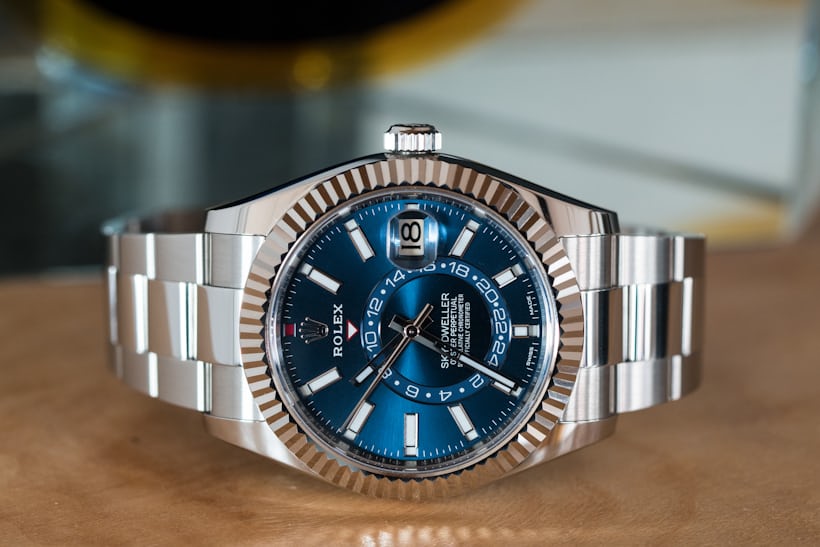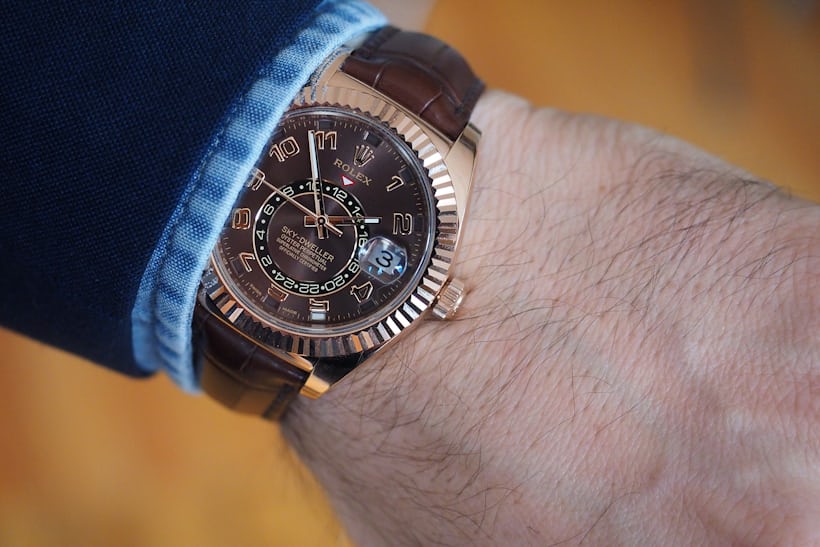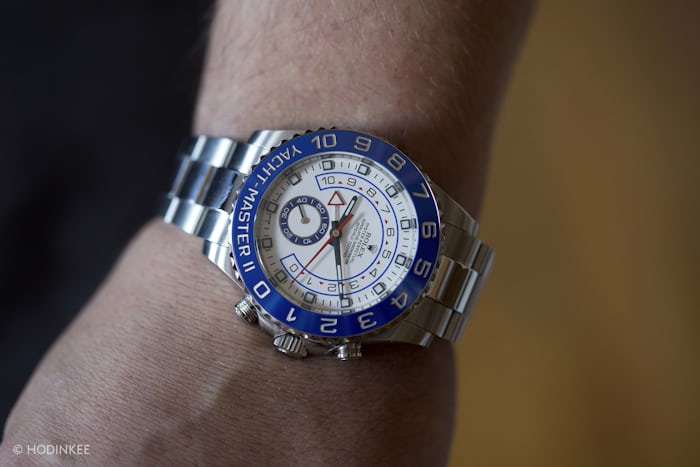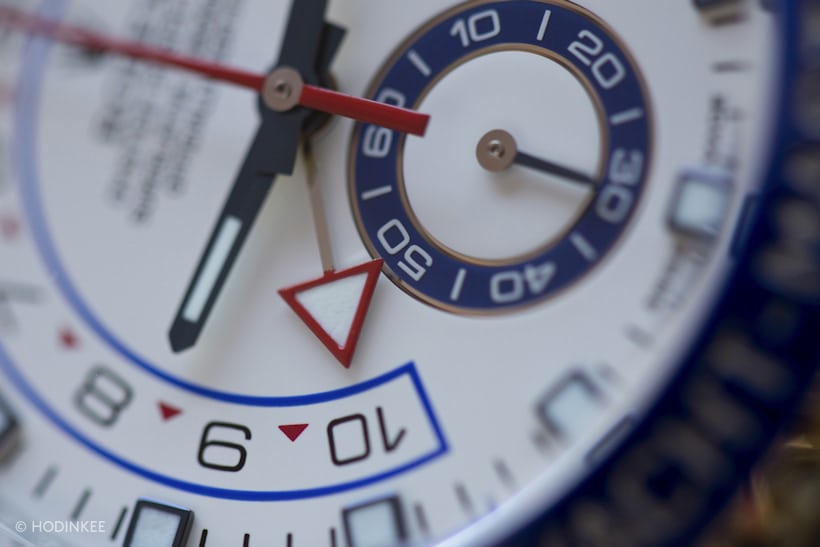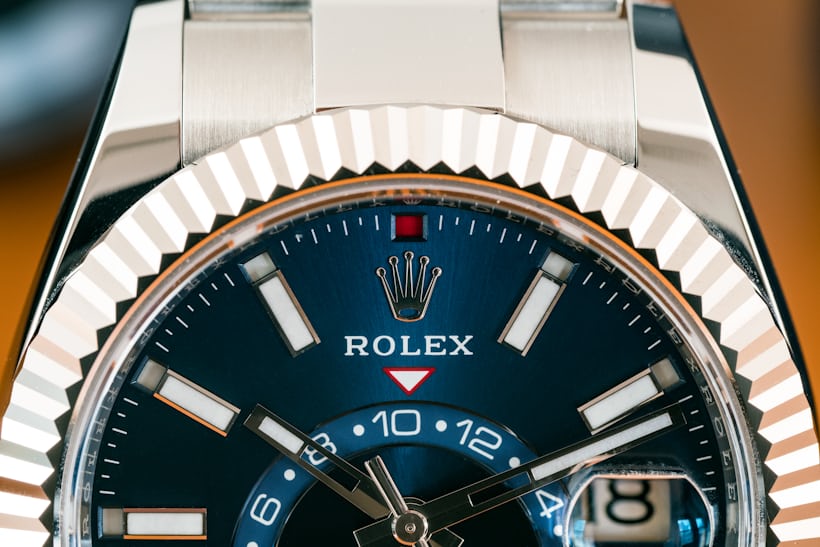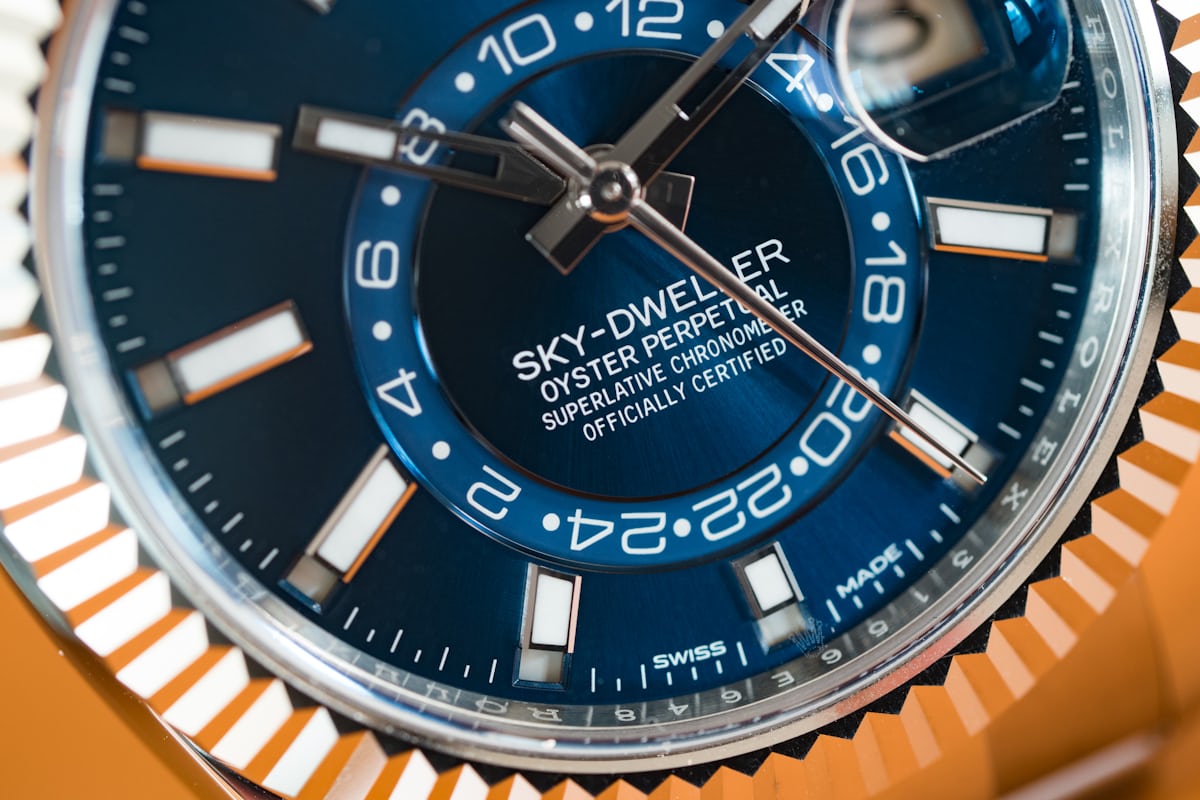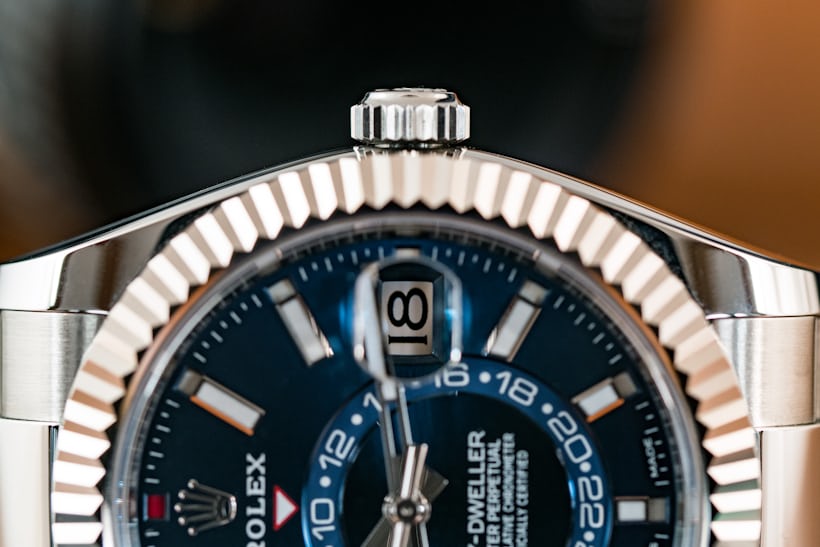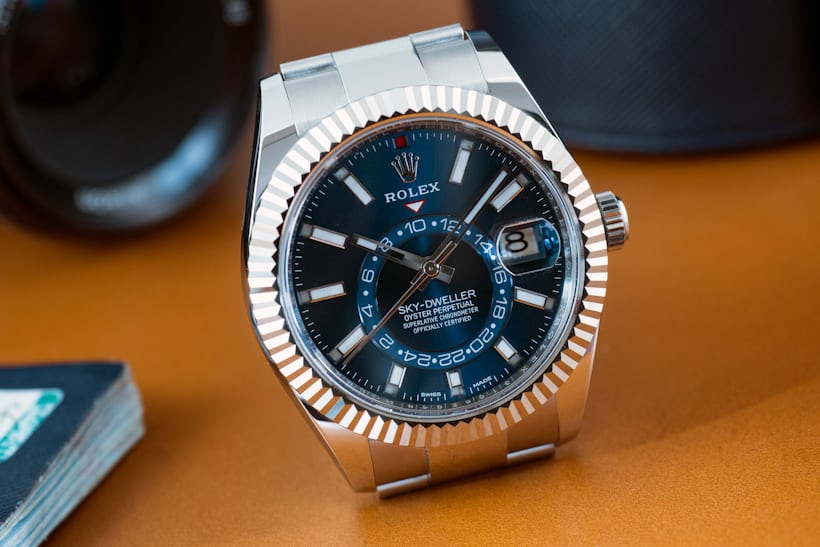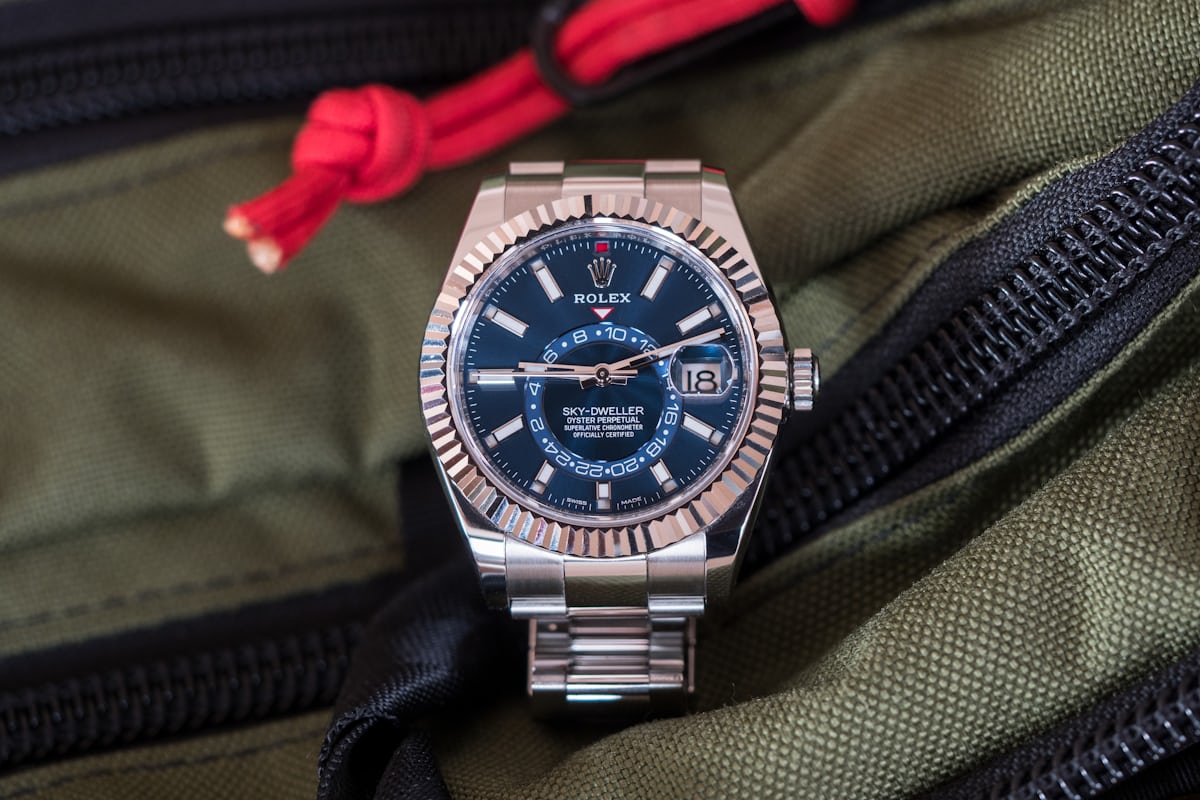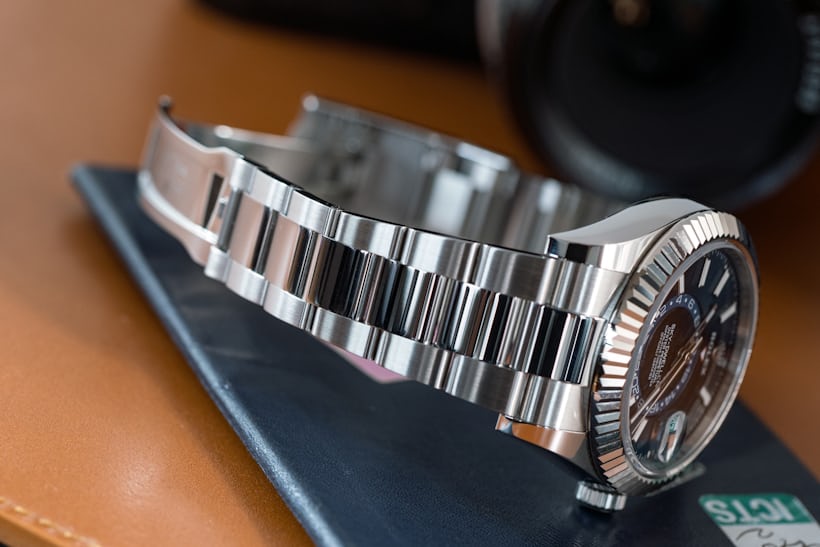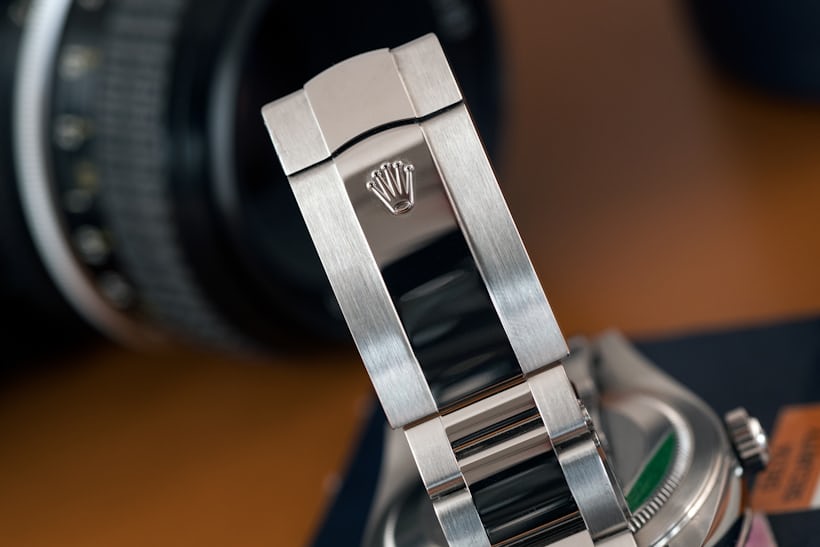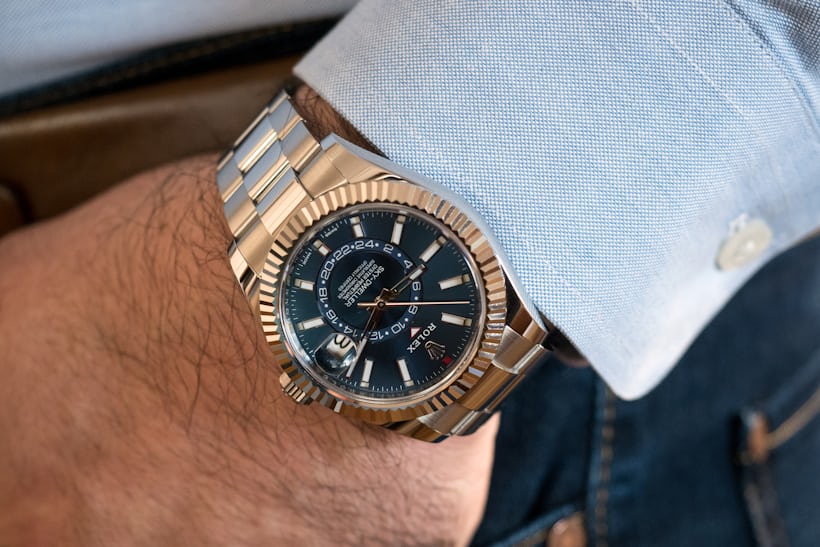The most down-to-earth version yet of the Crown’s high-flying traveler’s timepiece.
The Sky-Dweller has always had a slightly contradictory character. It’s the most complicated watch Rolex makes (in terms of mechanical complexity, it’s only rivaled by the Yacht-Master II) and when it was introduced in 2012, it was only available in precious metals. At the same time, it’s clearly intended to be an extremely practical watch – durable, easy to use, and easy to live with, even under the stress of navigating the world’s increasingly unfriendly skies. However, in 2017, Rolex introduced two Rolesor versions of the Sky-Dweller (Rolesor is the company’s term for its mixtures of steel with white or yellow gold) which immediately made this most practical of complicated watches, instantly more accessible. In Everose and on a strap, the Sky-Dweller is a $39,550 watch, and in white gold on a white gold bracelet it’s $48,850, which obviously makes precious metal versions of the Sky-Dweller as much statement pieces as anything else. (Jay-Z has been frequently spotted wearing a yellow gold Sky-Dweller, for example.) Though we’ve done A Week On The Wrist with a Sky-Dweller before, that was an Everose model on a strap and with the newer, less overtly luxurious models out, we thought this would be a good time to revisit the Sky-Dweller. The new version in steel, with a white gold bezel, is now the most affordable model, at less than half the price of the precious metal versions, and that’s the one we chose for our latest A Week On The Wrist.
The Sky-Dweller Reference 326934 is the first version of the watch to be offered in white gold and stainless steel.
Complications In The Rolex Sky-Dweller
The Sky-Dweller is a combination of two complications: a dual-time zone, or GMT complication, and an annual calendar. The former is easy to understand: the watch displays the time in two time zones simultaneously, and has an hour hand that can be independently set, forwards or backwards, in one-hour jumps. The latter is a feature of “true” GMT watches, as is the fact that the hour hand is set from the crown and can be re-set to a new timezone without stopping the entire watch. There are simpler dual time zone watches, which have a 24 hour hand that can be independently set, but to use them as a traveler’s watch – that is, to display local time with the hour and minute hands, and home time with the 24 hour hand – generally requires quite a bit more fiddling with the crown and also involves stopping the watch while re-setting the hour and minute hands, thus requiring the user to also re-set to a time standard.
The Rolex Sky-Dweller, as introduced in Everose gold, in 2012.
The annual calendar is the second complication found in the Sky-Dweller, and is also relatively straightforward. The Gregorian calendar has days of varying length – some months have 31 days, and others have only 30. Most notably, February is the oddest man out, and depending on whether or not it’s a Leap Year, can be either 28 or 29 days in length (29 in a Leap Year). A perpetual calendar watch automatically jumps to the first on the correct day at the end of the month, no matter the month (so, for instance, on February 28th in a non-Leap Year, and on February 29th in a Leap Year, the date will, at midnight, advance to March 1st). Thus, a perpetual calendar never needs to have the date adjusted manually. An annual calendar, on the other hand, “knows” (so to speak) if it’s a 30 or 31 day month but it does not know to jump to March 1 on February 28th or 29th. Thus, an annual calendar needs to have the date manually re-set once a year. Of course, a standard calendar watch has to have the date advanced manually five times a year – once for each 30 day month, and once at the end of February.
The annual calendar has some significant advantages over the perpetual, although some of these have been eroded in the last couple of decades by advances in perpetual calendar design. Relative to perpetual calendars, annual calendars have been generally mechanically less complex, as well as less apt to be damaged by mishandling on the part of their owners. Interestingly enough, the annual calendar is a quite recent innovation in wristwatches – it wasn’t until 1996 that the first patent for an annual calendar was granted, to Patek Philippe, who launched the complication in the reference 5035. Ironically, Patek’s original design was actually relatively complex but just as with the perpetual calendar, the last couple of decades have led to increasingly reduced parts counts, and Rolex’s annual calendar mechanism required the addition of only four wheels to the existing Rolex date mechanism.
The Ring Command Bezel
There is, arguably, a third complication in the Sky-Dweller: the Ring Command Bezel. The Ring Command Bezel was first introduced by Rolex in the Yachtmaster II – the other contender for Most Complicated Rolex. The Yachtmaster II was introduced by Rolex in 2007 and it’s a regatta timer. You can set the countdown for any interval from one to 10 minutes, and if you need to re-synch your seconds hand to the starter’s gun, you can do so by pushing the reset button while the chronograph is running. The seconds hand then flies back to zero and immediately begins running again, while the minute hand flies back to the nearest minute.
The Ring Command Bezel is used in the two most complex Rolex watches: the Yacht-Master II, and the Sky-Dweller.
In the Yacht-Master II, the Ring Command Bezel is used to control setting the programmable countdown timer.
In the Yachtmaster II, the Ring Command Bezel has two positions: neutral, and an active position reached by turning the bezel 90º to the left. Turning the bezel to the active position links the crown to the countdown minute hand, allowing the user to program the desired countdown duration (more in our Hands Onfrom 2015 right here).
Reading The Sky-Dweller Calendar And Time Zone
Before we get to the Ring Command Bezel’s implementation in the Sky-Dweller, let’s look at how the time and date are read off. Ideally, an annual calendar will offer some means of reading the month, which is necessary when setting the watch if the annual calendar is to do its thing accurately. The date can be read by checking the windows above the hour markers; since there are 12 months in a year, you can easily tell what month it is from the position of the red month marker. In the watch pictured, the 12th month – December – is indicated by the position of the red month marker at 12:00.
The month is shown by a red month indicator adjacent to an hour marker.
Home time is read off a rotating 24 hour ring.
Reading off home time is straightforward as well; it’s show by the rotating 24 hour ring which sits in the lower 2/3 of the dial (the triangle at 12:00 indicates the hour). This has the advantage of also showing whether it’s AM or PM at home. The annual calendar is linked to local time, which is shown by the hour hand, so that the date shown (assuming you’ve set the time correctly forwards or backwards for the new time zone) will be correct for your local time zone.
The overall fit and finish of the dial and case, by the way, is extremely good; even under magnification the dial markers, hands and numbers are all crisply defined, with irreproachable attention to detail. Rolex’s case and dial work is as uniformly excellent throughout its product lines as anything in the industry and what’s just as important, this excellence is consistent from watch to watch, and contributes greatly to the positive impression Rolex watches generally seem to make. I’m always struck by this whenever I handle one for review – even with Rolex models I wouldn’t necessarily wear on a daily basis myself, for reasons of either taste or practicality or cost, the general sense of exceptional build quality one gets is extremely high, from the humblest Oyster Perpetual to the most opulent Day-Date. One of the most essential ways in which any luxury brand can keep faith with its customers is in paying as much attention to the details in its least expensive products as in its most expensive, and Rolex is one of the very few watch companies I’ve written about over the years, for which this has always seemed to be true.
Using The Ring Command Bezel On The Sky-Dweller
The first thing you do when you take possession of a Sky-Dweller is set the time and date. In a watch with an annual calendar and dual time zone display, this would generally involve using some combination of the crown, and case pushers. The Ring Command Bezel is an alternative that allows all indications to be set with a crown that has only one setting position; although the mechanism is quite complex (over sixty additional parts) and requires a brief getting-acquainted period, it’s extremely easy to use in practice.
The date cyclops is present and correct; the fluted Ring Command bezel is used to control setting various indications.
To set the time, you first unscrew the crown and pull it out to the setting position. You then turn the bezel all the way to the left, as far as it will go (about 8:30 on the dial). This stops the second hand and engages hand setting; you can then set the time. In this position the hour hand and the 24 hour ring are kept synchronized.
Once you’ve set local and home time, you can change local time by unscrewing the crown and setting the bezel in its second position, by turning it to about 9:30. This engages the crown with the setting mechanism for the hour hand alone, which can now be set forwards or backwards in one hour increments (the date will switch at midnight as well, either forwards or backwards as needed).
Turn the bezel to the first setting position (about 9:30 on the dial) and you can set the month and date. There’s no separate quickset for the month, so you basically just keep turning the crown until the red indicator for the month is at the correct window (it will switch automatically from the 30th to the 1st, in 30 day months) and the correct date is shown.
The system is undoubtedly mechanically complex, but it is quite straightforward and simple in use. You can feel the position of the bezel as you move it thanks to very pleasantly engineered detents at each of the setting positions, and the whole system is not only satisfying to use, but a lot of fun as well, and certainly unlike anything you will find from any other brand. You also get a much cleaner case than you would if there were external pushers for setting the calendar or the local time, and greater ease of use than if you had to use a stylus for recessed pushers.
On The Road And In Air With The Sky-Dweller
In steel, with a white gold bezel, this is the most frequent-flyer friendly Sky-Dweller yet.
On both occasions that I’ve had a Sky-Dweller from Rolex for a test drive, I’ve also been able to take the watch on a test flight – this time, a quick business trip to London. Setting up the watch was very straightforward, and, as I’ve mentioned, fun as well. As I expected, in steel and white gold the Sky-Dweller feels very different from the frank opulence of the Everose model, and as it’s lighter than the all white gold version, it definitely seems less ostentatious. I don’t know that the Sky-Dweller would feel particularly utilitarian even in steel-only (though I think it would be great to have an all steel version of the watch) as it’s too large, and too brightly polished to ever project the tool-watch bluntness of some other Rolex sports models, but you certainly don’t feel as mogul’d up as you would with something in yellow gold or Everose. And of course, the steel and white gold model is almost entirely steel anyway.
Putting on the Rolesor version of the Sky-Dweller was a very different experience from putting on the Everose version I wore for our last Week On The Wrist with this model. As you’d expect, at 42mm in diameter and 14.10mm thick, the Everose version is a relatively heavy watch and a thoroughly luxurious one. The Rolesor version on a bracelet, thanks to its generally less extroverted character, feels to me, and will, I suspect, feel to anyone who travels primarily for business rather than pleasure, much lower key; it’s a much less a status-in-the-lounge and more a standing-in-line-at-a-security-checkpoint kind of watch (and I mean that in a good way).
That said, it still feels like a luxury watch, but that’s very much down to the excellent build quality throughout, rather than any use of luxury materials per se. Combining stainless steel and white gold (when I wore this watch on a late 2017 episode of Friday Live I mistakenly said the middle links and bezel were white gold, which several readers quite rightly corrected; mea culpa) is an intriguing decision, because obviously it’s very hard to tell which is which; there’s something almost perverse about it. It’s not something you have because it does anything in terms of projecting status, but I will say, it is, in a way I didn’t expect, nice to know it’s there. There is just something a little magical about a bit of gold, be it yellow, white, or Everose.
However, the luxury you get from the white gold and steel Sky-Dweller is largely that of something built and engineered with great care, attention to detail, and precision, not a luxury of materials or a luxury of manually executed decorative techniques.
Just as with the dial, dial furniture and hands, Rolex makes some of the best bracelets in the business; sized to fit my seven inch wrist, the Sky-Dweller was immediately comfortable and the visual impact of the electric-blue dial made it very enjoyable to wear. I generally like to re-set the time on my watch a few hours before landing, to just sort of get used to the idea of being in a different time zone gradually. In theory, you would think that recalling which of the bezel positions is used for re-setting local time might be difficult – one of my first thoughts on getting reacquainted with the Sky-Dweller was that some sort of function indicator would be nice – but in reality, I didn’t have any problem, even in the bleary dimness of a redeye flight cabin, remembering that two clicks to the left was correct.
The reality is that once the watch is set up, you’re just not going to have to touch the Ring Command Bezel that often, which given how enjoyable it is to use is almost a shame. You’ll need to remember that position 2 is for resetting the local time when you fly, and you’ll also need to remember that position 1 is for setting the date when you get to the end of February, but that’s once a year. And, obviously, the only time you’ll use position 3 is if for some reason you haven’t worn the watch for longer than 72 hours and you need to re-set the time. You probably won’t have to do that very often, either, at least not if your Sky-Dweller performs like mine – over a week and a half it gained maybe half a second a day, if that.
Interestingly enough, there are not many annual calendar watches with GMT complications out there, which is perhaps not surprising given the fact that the annual calendar is itself a somewhat rare complication (there are actually significantly fewer annual than perpetual calendars on the market in any given year). With a white gold bezel and steel case and bracelet, the Sky-Dweller is $14,400; a competing watch from Blancpain is the Villeret Annual Calendar GMT (our Hands On is right here) which in steel and on a steel bracelet is $23,700. The Sky-Dweller, of the two, is the larger watch (the Blancpain is 11.04mm x 40mm) and certainly the more outgoing of the two and if you like interacting with a machine that revels in its machine-ness, the Sky-Dweller’s your baby.
I liked the Everose Sky-Dweller on a strap and it would not be painful to wear it on a daily basis at all, but the steel and white gold version feels less like a celebration of status or achievement, and more like a trusted ally in the endless battle against disorientation and jet lag. In any case, I don’t think the Sky-Dweller really has any competition, at least not as an apples-to-apples comparison – the design, implementation of the annual calendar and second time zone display, and of course, the Ring Command Bezel all put it in a class of one.
The Rolex Sky-Dweller Ref. 326934: case and bracelet, 904L steel with white gold bezel, 42mm x 14.01mm, water resistant to 100 meters. Sapphire crystal with date cyclops. Movement, Rolex in-house caliber 9001 with center seconds, minutes and hours; independently settable hour hand and home time indication by 24 hour ring; annual calendar. Setting via the crown, controlled by Ring Command bezel, with 72 hour power reserve. More information, as well as an interactive setting guide, at Rolex.com.
Article by Jack Forster for hodinkee.com (January 4, 2018)
“Philippines’ Trusted Pawnshop and Buyer of Swiss Watches”
Landline: (02) 9943240

